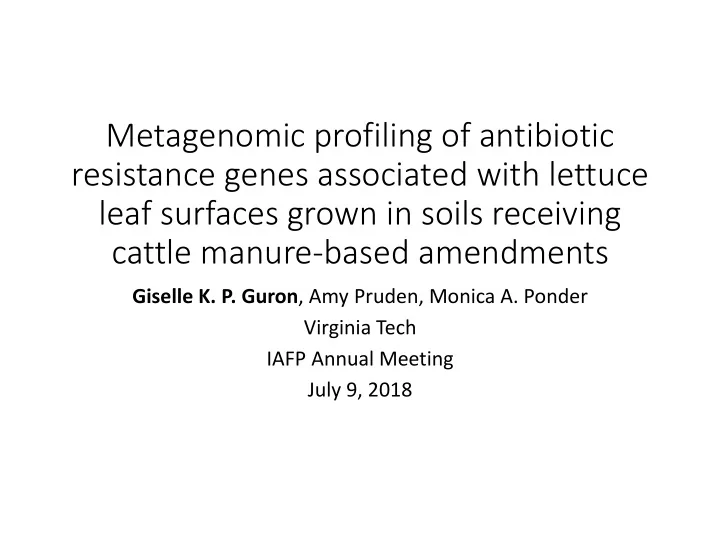

Metagenomic profiling of antibiotic resistance genes associated with lettuce leaf surfaces grown in soils receiving cattle manure-based amendments Giselle K. P. Guron , Amy Pruden, Monica A. Ponder Virginia Tech IAFP Annual Meeting July 9, 2018
Antibiotic resistance from foods? • Worldwide consumption of antimicrobials in livestock is projected to rise from over 60,000 tons in 2010 to over 105,000 in 2030 (Van Boeckel et al. 2015) https://www.cdc.gov/foodsafety
Interdisciplinary Approach Tracking Antibiotic Resistance from Farm-to-Fork Composting Animal Dosing Soil Application Education & Outreach Vegetables Postharvest
FSMA Regulations for Fresh Produce • The Food Safety Modernization Act (FSMA) outlines composting methods to reduce potential foodborne pathogens • Composting also benefits soil health and nutrient availability • Composting methods require minimum number of days ≥ 55 °C (21 CFR Part 112.54(b)) Temperature (°C) Pirlimycin Length of Composting (Day) Days Ray et al. 2017 J. Environ. Qual.
Methods to identify ARGs in foods • PCR-based methods • Antibiotic susceptibility testing and whole genome sequencing • High throughput sequencing (HTS)
Objectives • To use HTS to characterize ARG profile (or resistome) of lettuce grown in two different soil types amended with dairy cattle-based manure, compost, or chemical fertilizer • Identify putative markers of gene transfer co- occurring with ARGs
Cattle dosing and composting Alfalfa Hay Mulch Sawdust
Greenhouse Set-Up Soil Type Loamy Sand Silty Clay Loam Amendment Fertilizer Manure Static Type Control (FC) Compost Cattle Type From Control From Dairy (DC) Antibiotic- Treated Dairy (DA)
0.22-µm-pore 0.1% peptone (w/v) mixed cellulose 0.1% Tween 80 (w/v) membrane Diluent Membrane Rinse & massage 1/10 dilution (w/w)
Chloroplast 16S rRNA gene sequences Rarefaction to 12,700,000 reads each sample MetaStorm (https://bench.cs.vt.edu/MetaStorm/) Arango-Argoty et al. 2016 Direct annotation of reads (average length 101-bp) ARG idenfication: • CARD v1.2.1, modified (≥ 80% identity, ≥ 75 bp coverage) (Jia et al. 2017) • ARG-Miner v1.1.6, modified (DeepARG Machine Learning algorithms) (Arango-Argoty et al. 2017)
Results • CARD: 614 ARGs identified among 23 ARG classes • ARG-Miner: 3,249 ARGs identified among 26 ARG classes • The most genes shared between both databases: # genes unique # genes unique # common ARG Classes to CARD to ARGMiner genes Aminoglycoside 32 124 44 Beta-Lactam 68 417 47 MLS 15 428 60 Multidrug 28 284 111
ARGs identified using CARD Multidrug Trimethoprim Loamy Sand Silty Clay Loam Triclosan Tetracycline n = 2 Tetracenomycin n = 2 Gene copies/16S rRNA gene copies Sulfonamide Rifamycin Quinolone n = 2 n = 3 Polymyxin n = 3 Pleuromutilin n = 3 n = 2 Phenicol n = 2 n = 3 Peptide Nucleoside MLS Glycopeptide Fusidic Acid Fosfomycin n = 3 Elfamycin Bicyclomycin Beta-Lactam Bacitracin Aminoglycoside Aminocoumarin Manure Compost Manure Compost
Total ARGs affected by compost * soil Multidrug Trimethoprim Loamy Sand Silty Clay Loam Triclosan * Tetracycline n = 2 Tetracenomycin n = 2 Gene copies/16S rRNA gene copies Sulfonamide Rifamycin Quinolone n = 2 n = 3 Polymyxin n = 3 Pleuromutilin * n = 3 n = 2 Phenicol n = 2 n = 3 Peptide Nucleoside MLS Glycopeptide Fusidic Acid Fosfomycin n = 3 Elfamycin Bicyclomycin Beta-Lactam Bacitracin Aminoglycoside Aminocoumarin Manure Compost Manure Compost * p<0.05, Wilcoxon
ARGs identified by ARG-Miner Multidrug Tunicamycin Trimethoprim Loamy Sand Silty Clay Loam Triclosan Thiostrepton n = 2 n = 2 Tetracycline Gene copies/16S rRNA gene copies Tetracenomycin n = 2 Sulfonamide Streptothricin n = 3 Rifamycin n = 3 Quinolone n = 2 Puromycin n = 2 n = 3 n = 3 Polymyxin Pleuromutilin Peptide Mupirocin MLS Kasugamycin n = 3 Glycopeptide Fusidic Acid Fosmidomycin Fosfomycin Elfamycin Phenicol Beta-Lactam Bacitracin Manure Manure Compost Compost Aminoglycoside Aminocoumarin
Total ARGs affected by compost * soil Multidrug Tunicamycin Trimethoprim Loamy Sand Silty Clay Loam * Triclosan Thiostrepton n = 2 n = 2 Tetracycline Gene copies/16S rRNA gene copies Tetracenomycin # n = 2 Sulfonamide # Streptothricin n = 3 Rifamycin n = 3 Quinolone * n = 2 Puromycin n = 2 n = 3 n = 3 Polymyxin Pleuromutilin Peptide Mupirocin MLS Kasugamycin n = 3 Glycopeptide Fusidic Acid Fosmidomycin Fosfomycin # Elfamycin Phenicol Beta-Lactam Bacitracin Manure Manure Compost Compost Aminoglycoside * p<0.05, Wilcoxon; # ARGs significantly different only using ARG-Miner Aminocoumarin
Soil amendments cause shift in lettuce resistomes (ANOSIM, R>0.25, p<0.05) Amendments: DC Compost & DC Manure (R=0.543) DC Compost & DA Compost (R=0.629) DC Compost & FC (R=0.629) Soil Texture (R=0.350) • CARD v1.2.1, modified (≥ 80% identity, ≥ 75 bp coverage) (Jia et al. 2017)
Loamy Sand Silty Clay Loam DA Manure DC Manure DA Compost DC Compost Fertilizer DA Manure DC Manure DA Compost DC Compost Fertilizer Beta-Lactam antibiotic inactivation regulatory system Glycopeptide antibiotic sequestration molecular bypass regulatory system MLS macrolide inactivation streptogramin inactivation antibiotic target modifying efflux pump complex or subunit Multidrug antibiotic target modifying efflux pump complex or subunit regulatory system Polymyxin gene altering cell wall charge efflux pump complex or subunit Quinolone antibiotic target protection efflux pump complex or subunit regulatory system • Assembled, CARD v1.2.1, modified (≥ 60% identity, ≥ 75 bp coverage) (Jia et al. 2017)
Aminoglycoside Bacitracin Beta-Lactam Glycopeptide MLS Multidrug Phenicol Polymyxin Rifamycin Sulfonamide Tetracycline Triclosan Trimethoprim Intracellular mobile genetic element • CARD v1.2.1, modified (≥ 60% identity, ≥ 75 bp coverage) (Jia et al. 2017) • ACLAME v0.4, modified (≥ 60% identity, ≥ 75 bp coverage) (Leplae et al. 2010)
Conclusions • MLS ARGs and multidrug ARGs that utilize efflux mechanisms and corresponding regulatory systems were present on all lettuce • More ARGs were identified on lettuce grown in composted-amended loamy sand than from silty clay loam • Composts can shift lettuce leaf resistomes • More exploration needed for putative transposase and integrase genes co-localized with ARGs identified from manure-amended lettuce
Thank you!
Recommend
More recommend